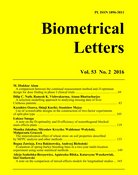
Biometrical Letters Vol. 53(2), 2016, pp. 133-147


Recycling of crop residues is essential to sustain soil fertility and crop production. Despite the positive effect of straw incorporation, the slow decomposition of that organic substance is a serious issue. The aim of the study was to assess the influence of winter wheat straws with different degrees of stem solidness on the rate of decomposition and soil properties. An incubation experiment lasting 425 days was carried out in controlled conditions. To perform analyses, soil samples were collected after 7, 14, 21, 28, 35, 49, 63, 77, 91, 119, 147, 175, 203, 231, 259, 313, 341, 369, 397 and 425 days of incubation. The addition of two types of winter wheat straw with different degree of stem solidness into the sandy soil differentiated the experimental treatments. The results demonstrate that straw mineralization was a relatively slow process and did not depend on the degree of filling of the stem by pith. Multivariate functional principal component analysis (MFPC) gave proof of significant variation between the control soil and the soil incubated with the straws. The first functional principal component describes 48.53% and the second 18.55%, of the variability of soil properties. Organic carbon, mineral nitrogen and sum of bases impact on the first functional principal component, whereas, magnesium, sum of bases and total nitrogen impact on the second functional principal component.

incubation process, multivariate functional principal component analysis, soil properties, winter wheat straws with different degree of stem solidness

